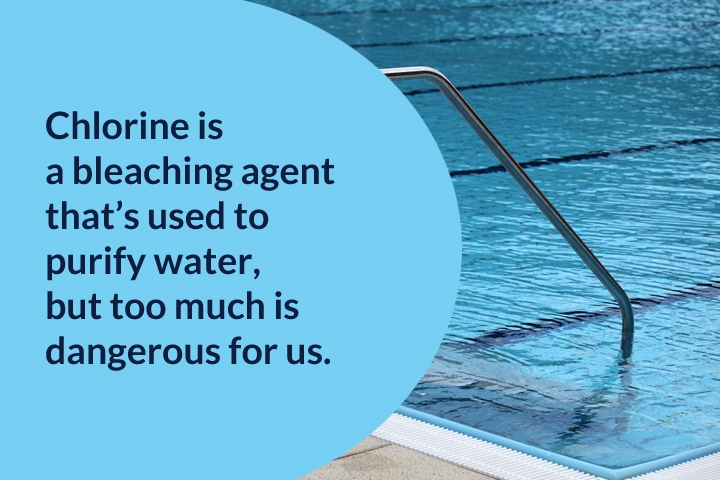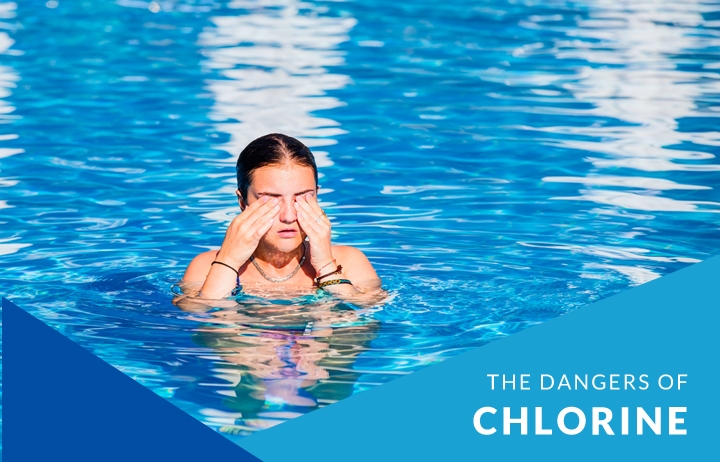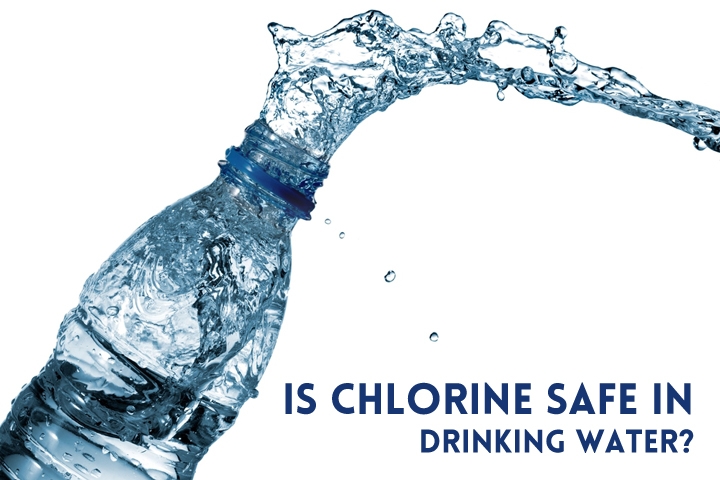The high content of chlorine in the typical pool makes it safer for you to swim in without contracting a disease, but people will also warn you not to drink the water. The warning also centers on the high chlorine content rather than the possibility that someone may have peed in the pool.
Most of us have experienced that terrible, sickly feeling after being in a pool for too long. That’s because it’s easy to swallow a little water while you’re swimming, and the chlorine that slips into your stomach can cause a serious stomach ache, and may even lead to vomiting and diarrhea.

The same thing can happen if your drinking water has too much chlorine in it. Chlorine is a bleaching agent that’s used to purify water, but too much is dangerous for us. So you should understand the way it’s used in drinking water and how improper levels can affect you.
The Dangers of Chlorine

Chlorine is a poisonous gas that’s found naturally in the environment. It was first discovered in 1774 by Carl Wilhelm Scheel, who mistook this gas for oxygen, which in its purest form can also be highly poisonous.
Humphry Davies properly named it in 1810, and also identified chlorine as a pure chemical element. In its physical form, it’s a diatomic green gas that’s extremely poisonous if you inhale it.
Davies was also involved in figuring out how to convert the gas into liquid form, which is how it’s used today for water purification. Though it takes a slightly larger dose to kill a human in liquid form, it’s still a poison.
That’s why too much chlorine in your drinking water can make you very sick or even kill you, although this is a fairly rare occurrence. What’s more, chlorine can actually react with the water and minerals in it to create other chemicals such as trihalomethanes (THMs). THMs have been linked to serious conditions in humans, for example: heart disease, asthma, eczema, and cancer.
The Necessity for Chlorine in Drinking Water
If chlorine can be such a dangerous substance when ingested, why is it a staple at all water-treatment plants? The short answer is that a bleaching agent such as chlorine is necessary to remove contaminants and protect your water.
Chlorine was deemed the safest and most effective bleaching agent for drinking water, and therefore became a standard in treatment plants across the U.S. On balance, it makes water much safer to drink.
We collect water from surface bodies such as lakes, reservoirs, and streams, but also from underground pools. Many, many contaminants may be found naturally in the earth, including bacteria and microorganisms that can make us sick or even kill you. But chlorine kills these contaminants instantly.
Also, after the water is collected, it runs through pipes that are not often cleaned. The pipes can be very dirty, and chlorine in the water helps to keep the liquid clean as it goes on its way.
Chlorine is also used in the treatment of water that has been shown to contain unsafe levels of a particular strain of bacteria or other dangerous constituents. There have been many reports of chlorine being used in an emergency to treat contaminated water.
Recently, a New Zealand town discovered that its drinking water was infected with E. coli, a toxic bacterium that can cause severe food poisoning and even death. For the safety of the residents, the management of the local water treatment plant chose to add a metered dose of chlorine to the water immediately to prevent infections.
Without the use of chlorine to solve the problem quickly, hundreds of residents might have become sick from the bacteria.
Is Chlorine Safe in Drinking Water?

Although chlorine is a poison, and the safety of drinking it can be questioned, the U.S. Environmental Protection Agency (EPA) has declared that chlorine in water is safe to drink in small amounts. Your body may build up a natural immunity to the gas over time that protects you from the negative health effects.
Even though it’s not an entirely safe chemical to consume, chlorine is a much better alternative to the array of communicable diseases that can be contracted through drinking water that has not been treated. Most cities will opt for the risks of increased chlorine in their water over a dangerous disease like E. coli.
Measuring High Levels of Chlorine
Though it’s necessary and safe in small amounts, you should monitor chlorine levels in your drinking water to protect yourself and family. The EPA warns that levels that exceed the regulated amounts will be harmful.
The agency’s conventions state that the allowable chlorine levels in drinking water may be up to 4 parts per million. This stipulation has a wide margin of error, so if higher levels of chlorine are mistakenly added, most drinkers will still be safe while action is taken to correct the error.
It’s worthwhile to note that water treatment facilities are responsible for testing your water, but they don’t always test often or accurately. The frequency of testing is directly linked to the quality of raw water and the population of drinkers.
If you live in a densely populated area with low-quality drinking water at its sources, the water is probably be tested every day. But if you live in a locale supplied with high-quality mountain spring water and fewer than 10,000 people, your water may be tested as seldom as once a month.
That’s when it’s essential to take water testing into your own hands. You can purchase water-testing kits from our shop that will specifically measure the levels of chlorine in your drinking water.
These tests can be more accurate than those used in water-treatment facilities because their tests only check the water in the plant. They can’t know what sort of contaminants and chemical reactions might take place between the time the water leaves the plant and when it reaches your faucets.
Testing your water often is the best way to enjoy peace of mind. If you discover that your water has higher-than-acceptable levels of chlorine, you must do several things.
First, stop drinking your water, obviously. Purchase high-quality bottled water instead. It’s all right to bathe and wash dishes in water with higher-than-normal levels of chlorine, but you shouldn’t ingest it until the problem has been addressed.
Call your water-treatment facility. The staff there can confirm the high chlorine levels and take proper steps to fix it and reduce the risk of customers getting sick.
Get Your Water Testing Kits from Test Assured Today!
Chlorine is just one of the many contaminants in water than can make you seriously ill or even lead to death if it’s not properly regulated. With our water testing kits, you’ll always know your water is safe.
We have tests that will check for lead, bacteria, pesticides, nitrates, chlorine, copper, iron, water hardness, and more. For more information about the many tests we offer and how you can achieve peace of mind with increased water safety, contact us today!

I’ve lived here for along time, however in the last 8 months the Water smells and tastes of Chlorine, Why does this happen, especially when I am paying for my water consumption.
If you can smell the chlorine in your tap water is it safe to drink? The taste of it is nauseating. Should I be drinking it? I live in Sudbury, Ontario Canada.
Yes, you can drink it. However: if you leave your water sitting out for a day or so (under a cloth, so the bugs don’t get in it) then most of the chlorine will evaporate.
What does a level 5 mean on a standard chlorine dip strip test?
Hi sir is it good chlorine 2.6 in drinking water?
My family moved in a small town the tap water has chlorine added most people complain but nothing is done . incorporated town..it makes us feel sick to drink ..kids skin is cracked on tender skin parts .and their is white buildup on the inner waterline connections..it reminds me of my hands when I did concrete work dry skin cracking
What should we do….from Harman wv
My water pipes, sink faucets are falling apart, extreme corrosion
How much chlorine van I safely put in 5000 liters container to clean it from iron
Using chlorine to remove iron isn’t something we can help you with, you might want to reach out to a specialist for that information.
The chlorine is so bad in our drinking water that our cats are having a hard time with it and water purifiers will not remove it what shall we do
what is the range of chlorine ratio between water and chlorine
What would this be in reference to?